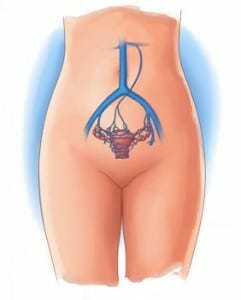About Pelvic Congestion Syndrome
Pelvic Congestion Syndrome (PCS), also known as Pelvic Venous Insufficiency (PVI), is a condition affecting women caused by abnormal veins in the pelvis. The veins which normally drain the blood from the pelvis become incompetent, the same way the veins in the leg fail in chronic venous insufficiency. This leads to reflux and pooling of blood in the pelvic veins and the veins become enlarged. The result is chronic pain and other symptoms. Approximately 30% of women who suffer from chronic pelvic pain have pelvic venous insufficiency.

Symptoms
PCS symptoms can include pain in the pelvic region and lower abdomen, pelvic heaviness, bloating sensation, painful menstrual periods, pain during and after sexual intercourse, backache, bladder irritation, pain or other symptoms with urination, abnormal bleeding, and vaginal discharge. Prolonged sitting or standing, walking, physical activity, sexual intercourse, and menstruation can increase the discomfort. Symptoms usually improve with lying down. Varicose veins on the upper thigh, buttocks, perineum, pubic area, and labia can also be seen with this condition.
Causes
Pelvic Congestion Syndrome is caused by failure of the veins which drain the blood from around the uterus and in the pelvis. These are called gonadal veins or ovarian veins. These veins become dilated and the valve system fails (the same way veins fail in chronic venous insufficiency in the legs). This results in pooling of blood in the pelvis. Pregnancy is the biggest contributing factor to this condition. Women of all ages can be affected, but the syndrome is most commonly seen in women who have had multiple pregnancies and who have not gone through menopause.
Diagnosis
Evaluation and diagnosis of PCS begin with a consultation including patient history and physical examination. If signs and symptoms suggest this condition, a CT scan is usually the first test that we perform to confirm the diagnosis. Ultrasound and MRI can also be used for diagnosis in some patients.
Treatment Options
If indicated, pelvic congestion syndrome is treated with a procedure called gonadal vein embolization which closes down the abnormal pelvic veins. This is a minimally invasive same-day procedure which is performed at the hospital by one of our interventional radiologists. The procedure is performed through a tiny incision just above the collarbone, and sometimes through a tiny incision by the hip.
Varicose veins associated with PCS in the upper thighs, labia, and buttocks usually don’t need to be treated if gonadal vein embolization is performed. If these veins need to be treated, they are usually treated with foam sclerotherapy in the clinic.
